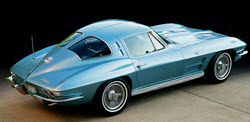1964 Corvette Sting Ray

The 1964 Corvette Sting Ray was quite similar to the celebrated 1963 Corvette Sting Ray. One of the most notable changes was the rear window. The 1963 Corvette Sting Ray had a split rear window, but due to safety concerns, all the following year models had ordinary non-split windows. When the single rear window became available, many owners of 1963 Corvettes actually had their old split window replaced by a single window. Today, the distinctiveness of the split window, combine with its extreme rarity, has made split-window Corvettes much more expensive than other Corvettes.
The 1963 Corvette Sting Ray had phoney hood vents, but these were not present on the 1964 Corvette Sting Ray since the designers felt that such additions were superfluous and made the design too busy. The hood indentations did however remain. The functionality of the air outlet located right of the driver’s door was increased – in 1963 they had been completely closed off. In the 1964 model, the addition of a small fan boosted the airflow and increased the efficiency. The air outlet was discontinued entirely by 1966.
Another difference between the 1963 Corvette Sting Ray and the new 1964 model was the noise level. New body mounting techniques, coupled with a few other changes, decreased the interior noise noticeably in the 1964 Corvette Sting Ray.
As for the engine, the 250 hp base motor and the upgrade L75 (300 hp) remained unchanged, but the L76 was boosted from 340 hp to 365 hp. To have the L76 engine, the Corvette buyer had to pay $108. This can be compared to $54 for the L75 300hp. The capacity of the L84 fuel injected model increased from 360 hp to 375 hp thanks to new heads, camshaft and valves. For this engine, you had to pay $538 and it was installed in less than 6 percent of produced cars. All variants of the 1964 Corvette Sting Ray utilized a 327 cubic inch motor.
The buyer of a 1964 Corvette Sting Ray had a lot of options and the original price of the car could be increased dramatically by opting for some of the tantalizing extras offered by Chevrolet. For an additional $630, you would for instance get the Special Sintered Metallic Brake Package. Even though 22,229 1964 Corvette Sting Rays were produced; only 29 cars had these special brakes. Power Brakes and Sintered Metallic Brakes (power 4) were considerably cheaper. The cost for Power Brakes was $43 and it was installed in over 2,000 cars. Sintered Metallic Brakes (power 4) for $54 were even more popular, and over 20 percent of the 1964 Corvette Sting Rays had them.
To make the ride even more stylish and enjoyable, the prospective owner of a 1964 Corvette Sting Ray could invest $81 in genuine leather seats, $422 in air conditioning, $177 in a built in AM-FM Radio and $59 in power windows. For an additional $16, all windows would be made of soft ray tinted glass. The AM-FM Radio turned out to be an especially popular addition and of the 22,229 cars produced, 20,934 had the AM-FM Radio – a whopping 94 percent!



